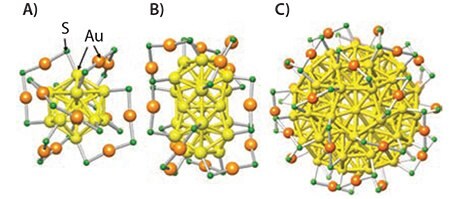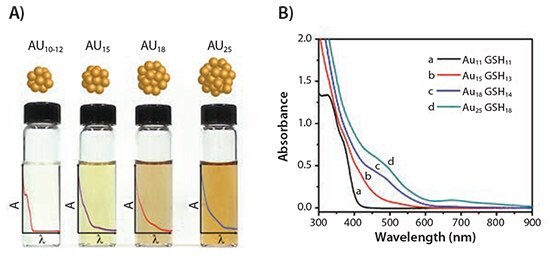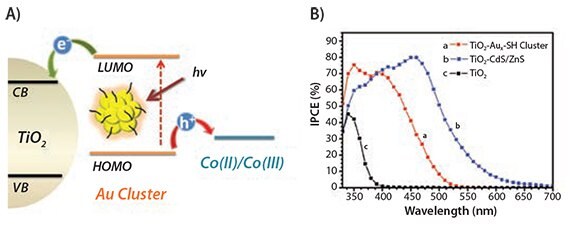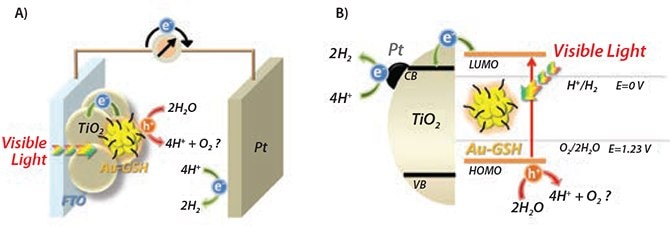Thiolated gold nanoclusters: A new class of photosensitizers
Kevin Stamplecoskie, Yong-Siou Chen, Prashant V. Kamat
Radiation Laboratory and Department of Chemistry and Biochemistry University of Notre Dame, Notre Dame, Indiana, USA
Introduction
The past several decades have seen major advancements in the synthesis of metal nanomaterials. Most recently, controlled synthesis has become versatile enough to regulate the exact number of atoms and ligands of very small metal nanoparticles, referred to as “clusters”. Unlike metal nanoparticles or even bulk metal, these clusters display interesting optical properties such as intense photoluminescence. The luminescence arises from discrete electronic energy level transitions that are available only in such extremely small particles. For this reason, clusters are considered to be molecule-like, behaving very different from other forms of metals. Clusters serve as a unique bridge between the singleatom limit and well-understood bulk materials. Due to their small size, the electronic and optical properties of clusters are drastically affected by the exact number of metal atoms that comprise their core and by the choice of coordinating ligand. The tunability with size/composition opens many new opportunities for using these clusters in fluorescence, such as biological imaging. Their long-lived excited states also make them an attractive new class of light absorbers for light-harvesting and energy applications.
Photovoltaic Properties of Gold Clusters
One commonly studied class of clusters is thiolate protected gold clusters, with the molecular formula AuxSRy. Many variations of these clusters have been made by varying the atom counts for the metal (x) as well as through the use of different types of coordinating thiols (y). For example, the most commonly synthesized/studied cluster has the formula Au25SR18 (25 gold atoms and 18 thiol ligands). The structure of Au25SR18, as well as other cluster sizes such as Au38SR24 and Au144SR60, have been determined by single crystal X-ray diffraction (XRD), illustrated in Figure 1. Au144SR60 displays molecule-like electronic properties, with discrete electronic states. Above this size, however, the number of atoms in the core is so large that their discrete electronic states are not distinguishable, and they behave as a metal with a full band structure. The optical absorption of particles larger than Au144SR60 is dominated by plasmon absorptions arising from collective oscillations of loosely bound electrons.

Figure 1. Crystal structure of A) Au25SR18, B) Au38SR24, and C) Au144SR60 as determined by XRD. The ligands have been omitted for clarity, only showing the S atoms (green). Reproduced with permission from Reference1. Copyright American Chemical Society.
Due to the small size of atomically precise clusters, the photophysical properties are strongly dependent on the exact number of metal atoms. In a recent study we have shown that the ability to absorb sunlight and the ability to convert sunlight to energy in photovoltaics is drastically influenced by the number of atoms.3 Figure 2 shows the absorption spectra of a series of glutathione-protected clusters containing different numbers of metal atoms (Au11, Au15, Au18, and Au25). In addition to the light absorption properties, the excited state behavior is also important in determining the light-harvesting potential of a light absorbing material. We are only beginning to understand the optical properties and excited state behavior of these clusters. A better understanding of their behavior promises new opportunities for discovery and optimization of materials for light-harvesting applications.

Figure 2. A) Different size cluster suspensions and B) corresponding absorption spectra. Reproduced with permission from Reference3.
Thiolated gold clusters do not exhibit plasmon resonance like larger size metal nanoparticles. They absorb visible light as indicated by the absorption spectra in Figure 2. With an increasing number of gold atoms, the absorption extends into the visible spectra. These clusters are highly photoactive and exhibit a long excited state lifetime (~780 ns).2 In smaller gold clusters, the ligand-to-metal charge complex dominates the excited state. In larger clusters (e.g., Au25GSH18) the core transitions contribute to the excited state decay and, thus, decrease the excited state lifetime. More detailed photophysical characterization of these gold clusters can be found elsewhere.3
The rich photochemistry of glutathione-capped gold clusters has enabled a new class of photosensitizers. Light harvesting in these gold clusters is made possible through the transfer of electrons to molecular species like methyl viologen. We have used transient absorption spectroscopy to establish the mechanistic and kinetic aspects of the photoinduced electron transfer processes in suspensions of these gold clusters.2–3
An important application of these gold clusters is in the area of lightenergy conversion. We have explored the photosensitizing ability of gold clusters by attaching them to mesoscopic titanium dioxide (TiO2) films. Aux-SH modified TiO2 mesoscopic films respond well to visible light excitation when employed as the photoanode in liquid-junction solar cells. Photocurrent action spectra of the metal cluster sensitized solar cell (MCSC) and cadmium sulfide (CdS)-based liquid-junction solar cells are compared in Figure 3. The photocurrent response matches well with the absorption of Aux-SH clusters. The maximum incident photon-tophotocurrent efficiency (IPCE) of 70% observed at 400–425 nm shows the gold clusters can harvest incident photons and efficiently convert them to electrical energy. These MCSCs exhibit maximum power conversion efficiency in the range of 2.03–2.36%, which is comparable to CdS quantum dot solar cells.

Figure 3. A) An illustration of the working principal of MCSCs. B) IPCE spectra (external quantum efficiency) of a photoelectrochemical cell using photoanodes composed of (a) TiO2-Aux-SH Cluster, (b) TiO2-CdS/ZnS, and (c) TiO2. Reproduced with permission from Reference4. Copyright American Chemical Society.
The gold cluster sensitized solar cells exhibit relatively high open circuit voltage (0.85–0.90 V) as compared to other sensitizing dyes. We have made use of gold nanoclusters to further boost the photovoltage of dye-sensitized solar cells employing a squaraine dye (Prod. No. 757233) and ruthenium polypyridyl complex as photosensitizer.5 An increase of ~100 mV is seen when gold clusters are co-anchored on TiO2 (Prod. Nos. 799289, 204757, 232033, and 248576) with other sensitizing dyes. These beneficial effects are attributed to the shift in Fermi level to more negative potentials as a result of electron accumulation in metal cluster co-sensitized solar cells.
Another interesting property of the gold cluster is its redox property. Cyclic voltammetry experiments have shown a large window for reversible reduction [E0= -0.63 V vs. RHE (reversible hydrogen electrode)] and oxidation (E0= 0.97 V and 1.51 V vs. RHE) processes. This property has further been explored to generate hydrogen in both photoelectrochemical cells and photocatalytic slurry systems (Figure 4). By anchoring the gold clusters on TiO2 particles, it is possible to inject electrons into TiO2 under visible light irradiation. These injected electrons were transferred to an active platinum catalyst site to reduced H+ ions into hydrogen. More details on the mechanistic aspects of solar fuel generation can be found elsewhere.6

Figure 4. Schematic of the working principle of (A) Aux-GSH sensitized TiO2 film as a photoanode of a photoelectrochemical cell (PEC) and (B) Aux-GSH sensitized Pt/TiO2 NPs photocatalytic system for water-splitting reaction under visible light illumination. Reproduced with permission from Reference6. Copyright American Chemical Society.
Summary
We have presented some interesting aspects of gold atom nanoclusters. The excellent photosensitizing ability of gold clusters renders them promising for light energy harvesting applications. Additionally, the high photoactivity, stability in aqueous medium, and biocompatibility make these clusters suitable as biotags or biomarkers.7 Since these photosensitizers are relatively new, efforts are still needed to explore them in energy generation and biological applications. As the scientific community explores to new design metal clusters with tailored ligands, one can expect additional applications of these metal clusters.
Acknowledgment
The research described herein was supported by the Division of Chemical Sciences, Geosciences, and Biosciences, Office of Basic Energy Sciences of the U.S. Department of Energy, through award DE-FC02-04ER15533. This is contribution number NDRL No. 5082 from the Notre Dame Radiation Laboratory.
Materials
References
如要继续阅读,请登录或创建帐户。
暂无帐户?